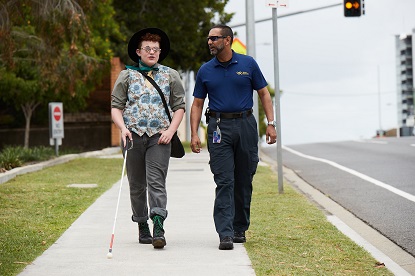The white cane is an important tool for independence and mobility among people who are blind or have low vision. Read on for what you need to know about the history and use of white canes.
The white cane is iconic
A long white cane is the mobility aid most people who are blind of have low vision choose to use. As it is so widely used, the white cane has become an internationally recognised symbol of blindness and low vision.
Where did it come from?
The cane has a long history as a mobility aid and has existed in various forms for nearly a century. In 1921, English photographer James Biggs became blind as a result of an accident and painted his walking stick white to be more easily visible. For this he is credited as the originator of the white cane.
Not all canes are the same
Canes can come in various types to support people with different kinds and degrees of vision impairment. Three main types of canes are:
- Long cane - A long mobility cane which enables a person who is blind or has low vision to use the cane to detect all obstacles and hazards within their path of travel by moving the cane in front of them.
- Identification cane - This cane is designed to be a visible signal to others that the user is blind or has low vision. People do not use identification canes to detect obstacles, but it can be used to assist with detecting the height of steps, gutters and down drops.
- Support Cane - This cane has more in common with a walking stick, and can be used to aid balance and as a means of physical support. Like the identification cane, this cane is not used to detect obstacles but can assist with identifying that a person has low vision.
Despite commonly being called white canes, canes come in a range of colours and are also made from different materials. There are also a range of different tips available for white canes to help people navigate different surfaces and environments.
Cane training
There’s more to properly using a white cane than just picking one up and heading off down the street. We recommend that people work with an orientation and mobility specialist to make sure they know how to use a cane effectively when out and about. Canes come in different sizes and an orientation and mobility specialist can provide expert advice about what type or size of can would best suit and individual.

Different options for different people
For some people who are blind or have low vision, their white cane might be their primary or sole mobility aid, while others may use it in conjunction with other strategies.
Many Seeing Eye Dog handlers will keep a white cane handy for when it might not be convenient to have their dog accompany them, for example when walking around their workplace or another area they are familiar with.
Technology like the Sunu Band or Miniguide use sonar and vibrations to alert people of obstacles, including those that may be out of reach of their cane.
Again, it’s important to get the right advice. Our orientation and mobility specialists can provide advice around whether a Seeing Eye Dog, technology or even smartphone apps might best suit an individual. Find out more here or contact us today on 1300 84 74 66.










